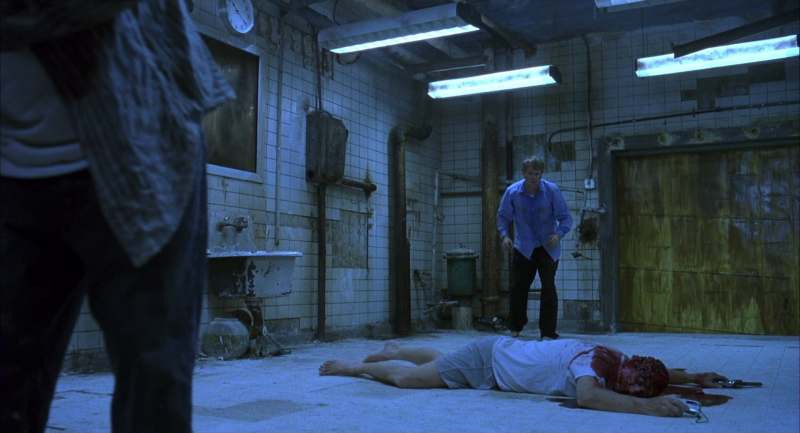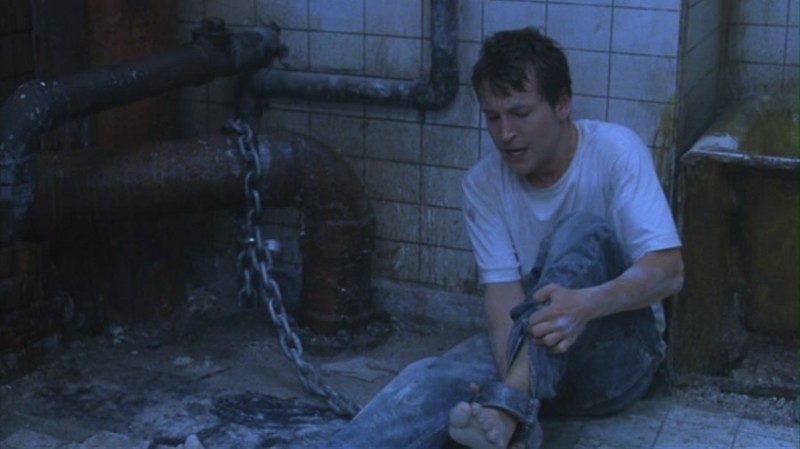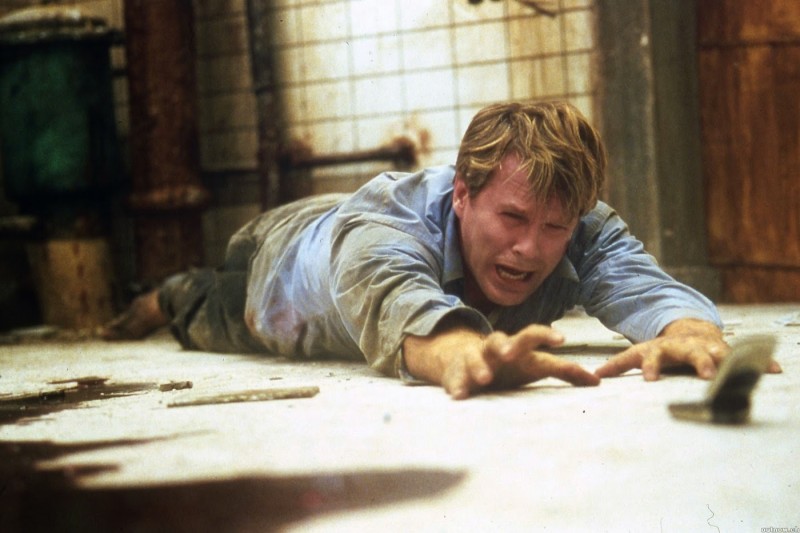Saw Review
"Re-released into theaters for its 10th Anniversary this week"
James Wan's
Saw forever changed modern horror by infusing the meticulous planning of Hitchcock and Clouzot, the grittiness of modern serial killer successes (
Silence of the Lambs and
Se7en come to mind), and the CGI enhanced gore made famous by fellow “Splat Pack”ers Rob Zombie and Eli Roth. Re-released into theaters this weekend for its ten-year anniversary,
Saw left an indelible mark on the horror genre, and is quickly becoming the
Nightmare on Elm Street /
Friday the 13th of the millennial generation.

Adam (Leigh Whannell) regains consciousness, gripped with fear, half submerged in a tub in a dark room. As he screams for help, the almost too calm voice of a stranger, Dr. Lawrence Gordon (Cary Elwes) urges him to calm down and regain his composure – despite their both being chained around the ankle to the wall. Dr. Gordon finds a light switch, bathing the tiny room in an eerie fluorescence, and introducing the men to their silent roommate – a corpse holding a gun in one hand and a tape recorder in the other. As the men begin their limited search of the room, they each discover tapes marked “play me,” containing instructions and clues to their means of escape. As Dr. Gordon and Adam sit solemnly in their small and filthy prison, the men find that they each have something in common as Dr. Gordon recounts his encounter with the “Jigsaw” killer.
Wan's direction style for
Saw can be easily quantified in one word: frantic. Using a strobe effect, and quick cutting, Wan can spin his audience around Jigsaw's victims as they writhe in the insidious contraptions of death. Used as a means of disorienting the audience, Wan's technique tries to instill the same panic of the trapped victims in his audience. Playing with the progression of time, his depiction of wild fearfulness becomes transplanted onto his audience, as is the victim's helplessness. Using abrupt back-and-forth cutting between Detective Tapp (Danny Glover) and the presumed Jigsaw killer as they partake in a car chase is almost directly attributable to the popular
The Fast and the Furious franchise that began in 2001.

In staunch contrast to James Wan's frenetic direction, is the plot's methodical and slowly unwinding narrative. Co-written by Wan and Whannell,
Saw was a fresh and innovative take on the classic serial killer plot. Vindicating the killer's motives by having him prey on drug addicts, and suicidal businessmen, Wan and Whannell have taken David Fincher's John Doe to a whole new level of justified slayings. In using victims that “deserve” harsh treatment, and using his torment as a way of forcing them to appreciate life. Jigsaw never plays an active roll in killing his victims. By setting them in bizarre contraptions, the victims have a choice about how far they are willing to go in order to survive. Heavily stacking the odds against them, Jigsaw is undoubtedly a psychotic madman, but his methodology encourage a dialogue between factions of the audience who align themselves on either side of the complex issue.

In no way a perfect horror movie (nor truly comparable to the works of Clouzot or Hitchcock), Wan's
Saw suffers from heavy-handed dialogue and stiff performances from nearly everyone involved. Elwes and Whannell never give the impression that they are actually panicked, and Elwes is a particularly befuddling character. Oddly calm, and prone to lashing out at inopportune times, he seems to be partly a manifestation of the “aloof surgeon” trope and a concerned father. Whannell portrays Adam as a sniveling “artist,” scratching out a living as an amateur private eye, and a general scumbag. Unsure of himself and brazenly ignorant, he seems torn between quiet intelligence and brash outbursts of stupidity. With each actor doing their best approximation of what it might feel like to be trapped in a decaying bathroom, the audience never feels any concern for their characters, and become far more interested in the larger “game.”
The 'Mouse Trap' of film,
Saw becomes far more fun to assemble and look at than something with which to become involved and interact. While it has made its mark on the horror genre,
Saw is far more interesting as a social commentary than a gripping piece of cinema. Robotic performances and ineffective camera movement aside,
Saw's incredible twists still pack a punch more than ten years later.
Pros
- Intricate and twist-filled plot
- A fresh take on the serial killer genre
Cons
- Poorly-delivered dialogue
- Additional unnecessary cliché elements in the plot (Danny Glover's character comes to mind)
 Adam (Leigh Whannell) regains consciousness, gripped with fear, half submerged in a tub in a dark room. As he screams for help, the almost too calm voice of a stranger, Dr. Lawrence Gordon (Cary Elwes) urges him to calm down and regain his composure – despite their both being chained around the ankle to the wall. Dr. Gordon finds a light switch, bathing the tiny room in an eerie fluorescence, and introducing the men to their silent roommate – a corpse holding a gun in one hand and a tape recorder in the other. As the men begin their limited search of the room, they each discover tapes marked “play me,” containing instructions and clues to their means of escape. As Dr. Gordon and Adam sit solemnly in their small and filthy prison, the men find that they each have something in common as Dr. Gordon recounts his encounter with the “Jigsaw” killer.
Wan's direction style for Saw can be easily quantified in one word: frantic. Using a strobe effect, and quick cutting, Wan can spin his audience around Jigsaw's victims as they writhe in the insidious contraptions of death. Used as a means of disorienting the audience, Wan's technique tries to instill the same panic of the trapped victims in his audience. Playing with the progression of time, his depiction of wild fearfulness becomes transplanted onto his audience, as is the victim's helplessness. Using abrupt back-and-forth cutting between Detective Tapp (Danny Glover) and the presumed Jigsaw killer as they partake in a car chase is almost directly attributable to the popular The Fast and the Furious franchise that began in 2001.
Adam (Leigh Whannell) regains consciousness, gripped with fear, half submerged in a tub in a dark room. As he screams for help, the almost too calm voice of a stranger, Dr. Lawrence Gordon (Cary Elwes) urges him to calm down and regain his composure – despite their both being chained around the ankle to the wall. Dr. Gordon finds a light switch, bathing the tiny room in an eerie fluorescence, and introducing the men to their silent roommate – a corpse holding a gun in one hand and a tape recorder in the other. As the men begin their limited search of the room, they each discover tapes marked “play me,” containing instructions and clues to their means of escape. As Dr. Gordon and Adam sit solemnly in their small and filthy prison, the men find that they each have something in common as Dr. Gordon recounts his encounter with the “Jigsaw” killer.
Wan's direction style for Saw can be easily quantified in one word: frantic. Using a strobe effect, and quick cutting, Wan can spin his audience around Jigsaw's victims as they writhe in the insidious contraptions of death. Used as a means of disorienting the audience, Wan's technique tries to instill the same panic of the trapped victims in his audience. Playing with the progression of time, his depiction of wild fearfulness becomes transplanted onto his audience, as is the victim's helplessness. Using abrupt back-and-forth cutting between Detective Tapp (Danny Glover) and the presumed Jigsaw killer as they partake in a car chase is almost directly attributable to the popular The Fast and the Furious franchise that began in 2001.
 In staunch contrast to James Wan's frenetic direction, is the plot's methodical and slowly unwinding narrative. Co-written by Wan and Whannell, Saw was a fresh and innovative take on the classic serial killer plot. Vindicating the killer's motives by having him prey on drug addicts, and suicidal businessmen, Wan and Whannell have taken David Fincher's John Doe to a whole new level of justified slayings. In using victims that “deserve” harsh treatment, and using his torment as a way of forcing them to appreciate life. Jigsaw never plays an active roll in killing his victims. By setting them in bizarre contraptions, the victims have a choice about how far they are willing to go in order to survive. Heavily stacking the odds against them, Jigsaw is undoubtedly a psychotic madman, but his methodology encourage a dialogue between factions of the audience who align themselves on either side of the complex issue.
In staunch contrast to James Wan's frenetic direction, is the plot's methodical and slowly unwinding narrative. Co-written by Wan and Whannell, Saw was a fresh and innovative take on the classic serial killer plot. Vindicating the killer's motives by having him prey on drug addicts, and suicidal businessmen, Wan and Whannell have taken David Fincher's John Doe to a whole new level of justified slayings. In using victims that “deserve” harsh treatment, and using his torment as a way of forcing them to appreciate life. Jigsaw never plays an active roll in killing his victims. By setting them in bizarre contraptions, the victims have a choice about how far they are willing to go in order to survive. Heavily stacking the odds against them, Jigsaw is undoubtedly a psychotic madman, but his methodology encourage a dialogue between factions of the audience who align themselves on either side of the complex issue.
 In no way a perfect horror movie (nor truly comparable to the works of Clouzot or Hitchcock), Wan's Saw suffers from heavy-handed dialogue and stiff performances from nearly everyone involved. Elwes and Whannell never give the impression that they are actually panicked, and Elwes is a particularly befuddling character. Oddly calm, and prone to lashing out at inopportune times, he seems to be partly a manifestation of the “aloof surgeon” trope and a concerned father. Whannell portrays Adam as a sniveling “artist,” scratching out a living as an amateur private eye, and a general scumbag. Unsure of himself and brazenly ignorant, he seems torn between quiet intelligence and brash outbursts of stupidity. With each actor doing their best approximation of what it might feel like to be trapped in a decaying bathroom, the audience never feels any concern for their characters, and become far more interested in the larger “game.”
The 'Mouse Trap' of film, Saw becomes far more fun to assemble and look at than something with which to become involved and interact. While it has made its mark on the horror genre, Saw is far more interesting as a social commentary than a gripping piece of cinema. Robotic performances and ineffective camera movement aside, Saw's incredible twists still pack a punch more than ten years later.
In no way a perfect horror movie (nor truly comparable to the works of Clouzot or Hitchcock), Wan's Saw suffers from heavy-handed dialogue and stiff performances from nearly everyone involved. Elwes and Whannell never give the impression that they are actually panicked, and Elwes is a particularly befuddling character. Oddly calm, and prone to lashing out at inopportune times, he seems to be partly a manifestation of the “aloof surgeon” trope and a concerned father. Whannell portrays Adam as a sniveling “artist,” scratching out a living as an amateur private eye, and a general scumbag. Unsure of himself and brazenly ignorant, he seems torn between quiet intelligence and brash outbursts of stupidity. With each actor doing their best approximation of what it might feel like to be trapped in a decaying bathroom, the audience never feels any concern for their characters, and become far more interested in the larger “game.”
The 'Mouse Trap' of film, Saw becomes far more fun to assemble and look at than something with which to become involved and interact. While it has made its mark on the horror genre, Saw is far more interesting as a social commentary than a gripping piece of cinema. Robotic performances and ineffective camera movement aside, Saw's incredible twists still pack a punch more than ten years later.